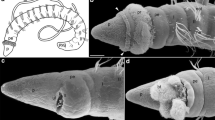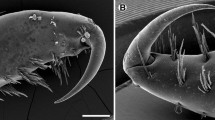Abstract
Radular function in the muricid gastropod Urosalpinx cinerea follyensis Baker during shell penetration was examined with slow-motion picture photography and scanning electron microscopy. Particular attention was paid to possible injury of buccal structures by radular cusps. The presence of a flexible cuticulated buccal armature, and delicate synchronization of movements of odontophoral cartilages, subradular membrane, teeth, and buccal mass, explain the absence of shredding of live buccal tissues. Some light abrasion was evident, but generally only in the cuticulated gully of the subodontophoral shield, on the rim of the jaw, and on the anterior edge of the esophageal valve. Rasping at the surface of incomplete bore-holes is done by major cusps of rachidian teeth over the bending plane. Marginal teeth lie on the slopes of the odontophore, generally remain depressed below the level of rachidian teeth, and thus scrape the shell only lightly, if at all. The sharp posteriorly recurved shape of central and lateral rachidian cusps enhances their scooping effectiveness. These teeth produce smooth, conspicuous traces in the soft shell of Mya arenaria and shallow traces in the harder shell of Mytilus edulis Linné. The impact of individual cusp strikes was not evident in traces. With wear, rachidian cusps become increasingly blunted, a reflection of their ploughing action over chemically weakened shell, and are eventually sanded flat. Marginal teeth wear primarily at their ends, the tips becoming truncated as they pass lightly over the shell surface. The advancing edge of the odontophore during rasping strokes, plotted on the image from motion pictures moves slowly at first, then more rapidly in the middle of the stroke, and slows again at the end. Duration of strokes ranged from 0.45 to 0.75 sec. Duration of rasping cycles varied from 1.3 to 2.0 sec. The number of transverse rows of teeth passing over the bending plane during the rasping stroke varied from 14 to 32, and the average time for the passage of one transverse row over the bending plane ranged from 20 to 48 msec. The number of transverse rows of teeth remaining exposed beneath the odontophore below the bending plane at the end of the rasping stroke, and between the bending plane and the anterior end of the sulcus in the radular diverticulum, was approximately 10.
Similar content being viewed by others
Literature Cited
Carefoot, T. H.: Magnetite in the radula of the Polyplacophora. Proc. malac. Soc. Lond. 36, 203–212 (1965).
Carriker, M. R.: On the structure and function of the proboscis in the common drill, Urosalpinx cinerea Say. J. Morph. 73, 441–506 (1943).
—: Boring gastropods (16 mm silent color motion picture). Am. Zool. 7, p. 797 (1967).
—: Excavation of boreholes by the gastropod Urosalpinx: an analysis by light and scanning electron microscopy. Am. Zool. 9, 917–933 (1969).
— J. B. Blake: A method for full relaxation of murcids. Nautilus 73, 16–21 (1959).
— and B. Martin: Analysis of shell boring behavior of the muricid gastropod Urosalpinx cinerea (Say) by means of color motion picture and microhydrophone recording of radular sounds. Am. Zool. 5, p. 645 (1965).
—, P. Person, R. Libbin, and D. Van Zandt: Regeneration of the proboscis of muricid gastropods after amputation, with emphasis on the radula and cartilage. Biol. Bull. mar. biol. Lab., Woods Hole 143, 317–331 (1972).
—, D. B. Scott and G. N. Martin: Demineralization mechanism of boring gastropods. Publs Am. Ass. Advmt Sci. 75, 55–89 (1963).
— and D. Van Zandt: Predatory behaviour of a shell-boring murieid gastropod. Chapter 5, In: Behavior of marine animals: current perspectives in research. Vol. 1. Invertebrates, pp 157–244. Ed. by H. E. Winn and B. L. Olla. New York: Plenum Press 1972a.
—: Regeneration of the accessory boring organ of muricid gastropods after excision. Trans. Am. microsc. Soc. 91, 455–466 (1972b).
— and E. L. Yochelson: Recent gastropod boreholes and ordovician cylindrical borings. Contr. Paleont., geol. Surv. Pap. 593B, B1-B26 (1968).
Fretter, V. and A. Graham: British prosobranch molluses, 755 pp. London: Ray Society 1962.
Graham, A.: The functional anatomy of the buccal mass of the limpet (Patella vulgata). Proc. zool. Soc. Lond. 143, 301–328 (1964).
—: The anatomical basis of function in the buccal mass of prosobranch and amphineuran molluscs. J. Zool. London 169, 317–348 (1973).
Gunter, G.: Radular movement in gastropods. J. Wash. Acad. Sci. 26, 361–365 (1936).
Hemingway, G. T.: Feeding in Acanthina spirata (Prosobranchia: Neogastropoda), 88 pp. Master's Thesis, California State University, San Diego 1973.
Hubendick, B.: The eating function in Lymnaea stagnalis (L.). Ark. Zool. Stockholm 10, 511–521 (1957).
Isarankura, K. and N. W. Runham: Studies on the replacement of the gastropod radula. Malacologia 7, 71–91 (1968).
Märkel, K.: Über funktionelle Radulatypen bei Gastropoden unter besonderer Berücksichtigung der Rhipidoglossa. Vie Milieu 17, 1121–1138 (1966).
Nisbet, R. H.: The structure and function of the buccal mass in some gastropod molluscs. L. Monodonta lineata (da Costa). PhD Thesis, University of London 1953.
Richter, G.: Die Schnecken “zunge” als Werkzeug. Natur Mus., Frankf. 92, 391–406 (1962).
Runham, N. W.: The histochemistry of the radula of Patella vulgata. Q. Jl microsc. Sci. 102, 371–380 (1961).
—: A study of the replacement mechanism of the pulmonate radula. Q. Jl microsc. Sci. 104, 271–277 (1963).
—: The use of the scanning electron microscope in the study of the gastropod radula: the radulae of Agriolimax reticulatus and Nucella lapillus. Malacologia. 9, 179–185 (1969).
— and P. R. Thornton: Mechanical wear of the gastropod radula: a scanning electron microscope study. J. Zool. London 153, 445–452 (1967).
— D. A. Shaw and R. C. Wayte: The mineralization and hardness of the radular teeth of the limpet Patella vulgata L. Z. Zellforsch. 99, 608–626 (1969).
Solem, A.: Malacological applications of scanning electron microscopy. II. Radular structure and function. Veliger 14, 327–336 (1972).
—: Convergence in pulmonate radulae. Veliger 15, 165–171 (1973).
Sollas, B. J.: The molluscan radula: its chemical composition and some points in its development. Q. Jl microsc. Sci. 51, 115–136 (1907).
Thomas, R. F.: A scanning electron microscope study of the marginal teeth of Nerita peloronta Linnaeus. Nautilus 84, 118–119 (1971).
Towe, K. M. and H. A. Lowenstam: Ultrastructure and development of iron mineralization in the radular teeth of Cryptochiton stelleri (Mollusca). J. Ultrastruct. Res. 17, 1–13 (1967).
Author information
Authors and Affiliations
Additional information
Communicated by J. Bunt, Miami
Rights and permissions
About this article
Cite this article
Carriker, M.R., Schaadt, J.G. & Peters, V. Analysis by slow-motion picture photography and scanning electron microscopy of radular function in Urosalpinx cinerea follyensis (Muricidae, Gastropoda) during shell penetration. Mar. Biol. 25, 63–76 (1974). https://doi.org/10.1007/BF00395108
Accepted:
Issue Date:
DOI: https://doi.org/10.1007/BF00395108




